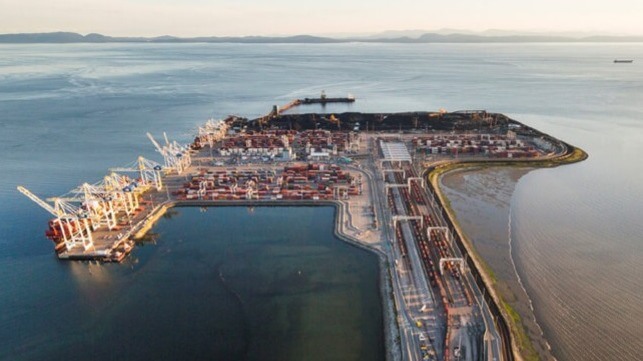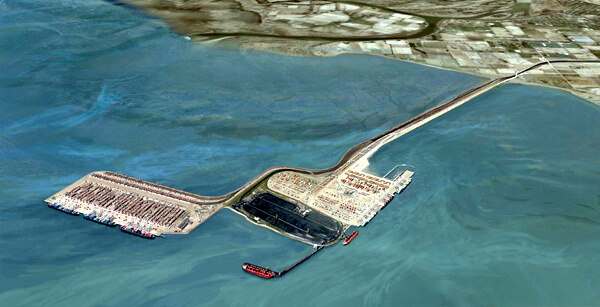Vancouver’s Controversial New Terminal Gets Consent with Conditions

A decade after Vancouver’s port authority proposed the construction of a massive new terminal to expand the port’s container handling capacity, the Canadian federal government has given its consent to the controversial project. The approval however includes an unprecedented level of legally binding conditions and a financial compliance requirement for the project which continues to be opposed by environmental groups, the longshore union, and the operator of an existing terminal.
Known as the Roberts Bank Terminal 2 (RBT2) Project, the Vancouver Fraser Port Authority plans to expand the existing container operations located about 20 miles south of Vancouver on Georgia Strait in the Fraser River Estuary. The project calls for the creation of a new man-made island adjacent to the existing terminal operated by Global Container Terminals (GCT) near the city of Delta, British Columbia. RBT2 would create three new berths and incrementally add an additional annual capacity for 2.4 million TEU or a 50 percent increase in capacity. Port officials emphasize it will be located in subtidal waters to reduce its environmental effects, but it does involve increasing the size of the turning basis as well as expanding the road network to support the operations.
Port officials highlight Canada’s west coast marine container terminals are forecast to hit capacity by the mid- to late-2020s, following a decade of five percent average annual growth. In 2022, the port handled an actual count of just under two million containers (3.55 million TEU). They point out that currently the port handles over US$200 billion in trade while saying the new facility is necessary for continued growth. They highlight the delays in cargo movement experienced over the past two years due to the surge in volumes and weather-related disruptions, such as the flooding in 2021, saying the RBT2 project would create a buffer to handle future surges in volumes.

Rendering of the proposed new man-made island and terminal expansion project (VFPA)
"The Government of Canada has approved the Roberts Bank Terminal 2 project, subject to 370 legally binding conditions,” said Jonathan Wilkinson, Canada’s Minister of Natural Resources. “Today's decision is based on the clear and compelling need for expanded container capacity on the West Coast, the robust mitigation measures that will be required of the proponent and that address key areas of environmental concern, and the support of the project from a number of First Nations."
Environmental groups have led the opposition to the project. They cite reports that said there would be a negative impact on the area’s wetlands, barn owls, Dungeness carb, chinook salmon, sandpipers and other shorebirds, and southern resident killer whales.
In response to the concerns, the approval came with 370 legally binding conditions which the government says will protect the environment, local wildlife, and land-use activities of Indigenous Peoples. There are over 100 measures to protect the local wildlife including the development of monitoring and mitigation programs. Procedures would delay departures and movements of container vessels when the presence of whales is detected in the area. The in-water construction would be limited to periods of the lowest risk to marine life in addition to requirements for infrastructure to permit the safe passage of fish such as the region’s salmon. As part of the terminal operations, they are also requiring the use of zero-emission cargo handling equipment and the installation of shore power capabilities so the vessels would cold iron while on dock.
As a condition of approval of the project, the federal government is also stipulating that the Vancouver Fraser Port Authority must also put in place a C$150 million (US$110 million) financial guarantee to ensure funds are available for the first three years of construction to comply with these legally binding conditions. Canadian regulations also require the port authority to be self-funding, meaning it must raise the estimated C$3.5 billion (US$2.5 billion) required for the construction through private investment, bonds, and leasing revenues.
"These mitigations don't actually work,” Charlotte Dawe, Conservation and Policy Campaigner at the Wildness Committee, told CBC News after the government’s announcement. “They're just used as excuses and ways to kind of grant projects like this an approval when they really shouldn't have one.” In its written statement, the organization said, “The panel determination should have signified the end for this harmful and shortsighted project by the Port of Vancouver.”
Environmentalists are not alone in their opposition with the International Longshoremen & Warehouse Union Canada and rival terminal operator GCT also opposing the project. The union is already fighting against automation in the port. Earlier in April, the ILWU petitioned for mediation in its current contract negotiations with automation being one of the points of contention.
GCT put forth its plan called Deltaport 4, to add a new berth which it says along with other improvements could address the need for added capacity. DP World, which operates another of Vancouver’s container terminals, in February 2023 reported it had completed construction on its expansion project increasing capacity at the Centerm terminal. When fully implemented later this year, it will add two-thirds to the terminal’s container handling capacity rising from 900,000 to 1.5 million TEUs.

that matters most
Get the latest maritime news delivered to your inbox daily.
The port authority has committed to bringing a third operator to the port beyond GCT and DP World. They said having a third operator for RBT2 would increase competition and provide choice for the shipping lines while also ensuring the port grows to prevent volume loss to the U.S. and Mexico.
The government approval for the new terminal project is an incremental step in the process. The port authority can now apply for the additional authorizations and permits required from the federal government and the government of British Columbia. The port authority says a final investment decision has not yet been reached and it would take an estimated six years to construct the new terminal facilities.
